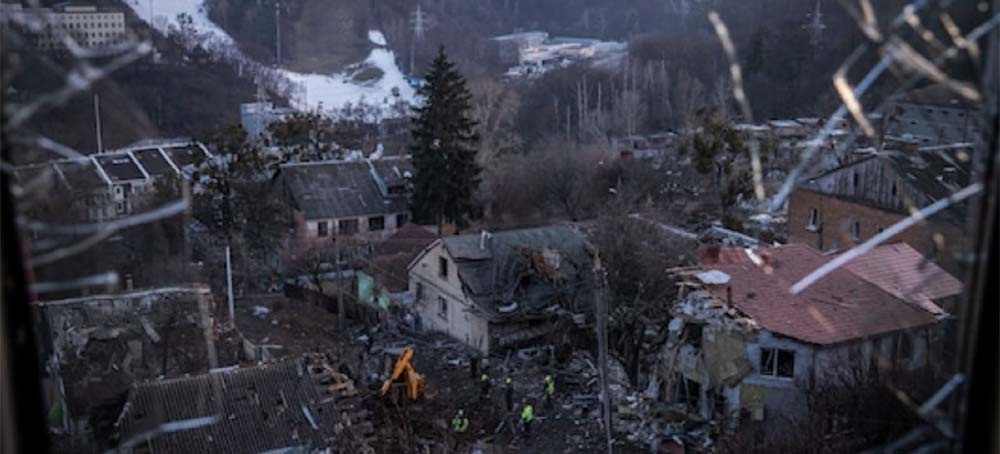Live on the homepage now!
Reader Supported News
In order to secure enough votes to become speaker, he will have to make a bargain with more than one devil.
Remember Richard Harris in the egregious 1970 movie, A Man Called Horse, in which Harris is a British nobleman who joins the Sioux, but not before he completes initiation rites that include being hung up by the thorax with pins? Next week, McCarthy will undergo something similar—except, unlike Harris' John Morgan, McCarthy also will have to listen to Marjorie Taylor Greene. The arrangement is blatantly unconstitutional as a violation of the Eighth Amendment. It's cruel and she's unusual.
You see, McCarthy wants to be speaker of the House of Representatives. Nero didn't want to be emperor as much as McCarthy wants to be speaker. Poisoning his rivals being unavailable as a campaign strategy, McCarthy has determined instead to further poison the political culture. He has already promised endless snipe hunts into everything from the administration's COVID and border policies to Hunter Biden's laptop, soon to replace “But Her Emails” as shorthand for pointless wastes of time, money, and political energy, all of which would be better spent on actual problems. He's even teeing up the January 6 select committee. From the Washington Post:
McCarthy’s letter echoes the desire of many other Republican lawmakers to aggressively go after the Jan. 6 committee, which they have long criticized as a purely political vehicle to attack former president Donald Trump. Rep. Jim Jordan (R-Ohio) — the likely next chairman of the House Judiciary Committee — and his staff are already preparing to examine any evidence omitted from the final report that is more flattering or at least exculpatory about Trump’s actions leading up to the Jan. 6 assault, according to one Republican operative who spoke on the condition of anonymity to describe GOP strategy.
Only McCarthy's vestigial conscience can tell him if the gavel is worth his coming humiliation. At the moment, for all his truckling and groveling, he still might not have the votes. Largely through the efforts of the people he's currently placating and the former president* to whom they remain enthralled, the new Republican majority in the House is a slim 10 votes, which means that—assuming no Democrats vote for him, and god help any who do—with six new members already on record as refusing to vote for him, McCarthy is two votes short of what he needs. Since the establishment of the Constitution, only 14 elections for speaker have gone to multiple ballots; the last of them occurred in 1923, the only time it's happened in the years since the Civil War.
I don't think I want to know what McCarthy is going to have to do in order to get the votes he needs. I hope he has a strong thorax.
Frederick Huntington Gillett was a career Republican politician of the old WASP school in Massachusetts: a graduate of Amherst College and Harvard Law, Gillett did a turn as assistant attorney general for the Commonwealth (God save it!), did a year in the state House of Representatives, and then got elected to Congress, where he served from 1893 to 1925. After leaving the House, he got elected to a single term in the Senate and then died in 1935. But it was in January 1923 that Frederick Huntington Gillett becomes relevant to current events.
Four different political parties sent representatives to the House in the election of 1922. In addition to Republicans and Democrats, two were from the uniquely Minnesotan Farmer-Labor Party; one of them had defeated Andrew Volstead, the Republican whose name had become synonymous with Prohibition; and the other was Socialist Victor Berger of Wisconsin. Everything in politics was rather fluid. The Republicans lost 77 seats, which still left them with a 17-seat majority. The older Republicans were still divided over the 1912 election, and the old Bull Moose hands refused to follow Sen. Robert LaFollette, the putative Republican congressional leader. The anger around bonus payments to veterans of World War I was still raging, and Prohibition, which outlasted Volstead, had everybody furious. In this atmosphere, the House of Representatives met in January of 1923 to elect a Speaker for the upcoming 68th Congress.
Gillett was the incumbent, having served as speaker for the previous two Congresses. But on the first ballot, Gillett received only 197 votes, two more than the Democratic candidate, Finis J. Garrett of Tennessee. Since 212 members didn't vote, no candidate received a majority of the votes of the membership. Enough Republicans opposed Gillett to prevent his election; Gillett was considered the establishment candidate by a rump faction of party rebels. The election for speaker ground on through nine roll calls. Finally, Rep. John Nelson, a Wisconsin Republican, managed to broker a deal. The renegade Republicans would support Gillett if he agreed to certain procedural reforms. Majority Leader Nicholas Longworth, TR's womanizing son-in-law and famous cuckold, agreed to the arrangement and Gillett spent one more term as speaker. Two years later, Gillett was gone and Longworth had replaced him.
It's long since become plain that McCarthy cannot become speaker without a series of devil's bargains with the Republicans who have announced their opposition. The difference between his situation and Gillett's is that the latter was opposed by Republicans who stood for progressive ideas and concrete programs. McCarthy is opposed by Republicans who stand for angry phantoms and internet delusions. Gillett's opponents set as the price for their votes the further democratic reforms to the way the House worked, particularly its committee structures. McCarthy's opponents would rather the House—and therefore representative democracy—not work at all, except for the hunting of snipes and as an audition space for the Fox News Channel. Getting those last five votes means romancing the likes of Andy Biggs and Matt Gaetz. It also may depend on what happens with New York's congressman-elect George Santos, The Man Who Wasn't There.
Being speaker is not worth this. Hell, Nero's ambitions weren't worth this.
READ MORE  Execution chamber. (photo: California Department of Corrections and Rehabilitation/Getty Images)
Execution chamber. (photo: California Department of Corrections and Rehabilitation/Getty Images)
After a series of botched executions, the state is choosing a path of technical, rather than moral, innovation.
On July 28, Alabama executed Joe Nathan James Jr., a convicted murderer. And, for some reason—the precise cause remains a mystery because of the extreme degree of confidentiality the state guarantees its executioners—the execution team working that night botched their task badly, piercing James all over his body before evidently cutting into his arm, presumably in search of a visible vein in which to insert an IV catheter. They nevertheless managed to kill him, the results of their work clear in the early-August autopsy I witnessed. I left that experience convinced that Alabama’s next execution would also likely unfold against protocol.
With that in mind, I headed to Alabama again on September 22, the scheduled execution date of another man, Alan Eugene Miller. I was there that night when, after an hour or more of failed attempts, executioners exhausted their efforts at getting two needles into two of Miller’s veins, and state authorities called off his death.
Undaunted by their two consecutive failures in the execution chamber, Alabama promptly scheduled another death-row prisoner, Kenneth Smith, to die. I immediately made Smith’s acquaintance and agreed to attend his killing as well. On November 17, Alabama again tried and again failed to execute its man. Smith spoke with me later that night, once he was back in his cell, and told me how his would-be executioners had pierced his arms and hands and finally his neck underneath his collarbone before abandoning their efforts.
At that point, Alabama finally acknowledged what had been clear to me since early August: Inside the state’s execution chamber, there is a crisis deserving of investigative review. On November 21, Governor Kay Ivey ordered a temporary halt to executions so that the Alabama Department of Corrections could assess its execution methodology and personnel before moving forward. But this is not to say that Alabama is evolving; if notions of progress were distributed evenly among the states, this would be the point in the story where I would be able to report that this series of botched executions had caused Alabama’s leaders to consider abandoning the death penalty altogether. Instead, Alabama is choosing a path of technical, rather than moral, innovation.
The state appears to be preparing to premiere a new kind of execution by lethal gas. In the gas chambers of old, little cells were filled with poison that eventually destroyed the organs of the trapped prisoners, resulting in death. Now Alabama proposes to use nitrogen gas to replace enough oxygen to kill via hypoxia, an untested method once imagined in a National Review article and made manifest in a plastic gas mask.
Chief Justice Earl Warren made a certain presumption about the relationship between moral and technological progress, and that presumption shaped his interpretation of the Eighth Amendment, which bans cruel and unusual punishment. It went like this: As societies develop, their moral sensibilities tend to become more refined as well. Or, as Warren put it, writing in Trop v. Dulles, “The Amendment must draw its meaning from the evolving standards of decency that mark the progress of a maturing society.” In other words, Americans ought to aspire to more and more humane means of punishment, and the law ought to be understood as cooperative in that effort.
And yet, though several methods of execution have fallen into disfavor across history, the Supreme Court has never formally banned one, instead allowing states to choose from many archaic ways to kill prisoners. Lethal gas, for example, remains an artifact of the past and a specter of the future, both lethal injection’s inferior predecessor and its current statutory alternative in a small number of states—Alabama among them.
America’s executions with gas began roughly 100 years ago, at the outset of a century that would witness the industrial-level use of cyanide in Germany’s death camps. Scott Christianson’s book The Last Gasp: The Rise and Fall of the American Gas Chamber notes an inflection point in America’s experiment with gas in March of 1921, when Nevada Governor Emmet Boyle signed the Humane Execution Bill into law, requiring future executions to be carried out with lethal gas. The new law endeavored to replace older, uglier methods—hanging and electrocution—with a manner of dying that was promised to be painless and bloodless. Instead, on February 8, 1924, Nevada prison officials led the Chinese immigrant Gee Jon to a converted stone barber house that would be flooded with a gaseous form of hydrocyanic acid commercially known as cyanogen, a highly toxic substance used industrially to manufacture fertilizer and exterminate insects. Witnesses watched through the brick outbuilding’s window that morning as Gee gasped and convulsed amid the haze of lethal gas that filled the chamber. One military physician who observed the execution that day would later report that the death house’s heating had failed, causing the gas to partially liquefy rather than vaporize, then collect on the floor of the chamber where it remained in a deadly pool for hours after Gee’s death. That same physician would also later speculate that Gee, who had been poisoned on a frigid day at roughly 9:45 a.m. and who was not removed from his shackles until after noon, had likely died of cold and exposure.
Nevertheless, the execution was hailed as a coup for progress: Finally, after all of the bodies twisting on nooses and smoking under electrocution hoods, there was a scientific, humane execution method. Around the world, people took note: In Soviet Russia, Leon Trotsky was certain that America would soon turn its dastardly weapons on revolutionary Europe; in Germany, the news was met with great interest by researchers for the cyanide industry and budding fascists alike.
More than 600 people have died in American gas chambers since Nevada’s 1924 experiment. Remarkably, states used gas to execute prisoners even after the term gas chamber became synonymous with Nazi Germany. Though the chamber had promised instantaneous and painless death, the ugliness and risk of its application eventually made it the country’s shortest-lived method of execution, Deborah Denno, a professor at Fordham University School of Law, told me. In plain view of witnesses, prisoners died screaming, convulsing, groaning, and coughing, their hands clawing at their restraints and their eyes bulging and their skin turning cyanic.
The last of them, Walter LaGrand, was killed in Arizona in 1999. Despite the length of time separating his death from Gee’s, he endured a similarly troubled execution: LaGrand, a German-born American who was convicted of murder, gagged and hacked and then died over the course of 18 minutes. Knowing what prison authorities intended to do well before they strapped LaGrand into the black harness that would contain his body as he choked on poison gas, the government of then–German Chancellor Gerhard Schröder had tried diplomatic interventions to save the man’s life. The irony was lost on Arizona.
Alabama has something slightly different in mind. Nitrogen hypoxia is the dream of Stuart Creque, a technology consultant and filmmaker who, in 1995, proposed the method in an article for National Review, in which he speculated optimistically about the ease and comfort of gas-induced death. After hearing about the potential of nitrogen hypoxia as a lethal agent in a BBC documentary, Oklahoma State Representative Mike Christian brought the idea before Oklahoma’s legislature in 2014 as an alternative to lethal injection. Oklahoma passed a law permitting the use of nitrogen hypoxia as a backup method of execution in the event that lethal injections could no longer be carried out. Mississippi passed similar legislation in 2017; Alabama followed in 2018. With Missouri, California, Wyoming, and Arizona (which have older lethal-gas statutes still on the books), these three nitrogen-curious newcomers make up the handful of governments that could begin attempting to execute people with lethal gas at any time. (Alabama Department of Corrections did not immediately reply to a request to comment for this article.)
Alabama is by no means the ablest of these states, but it is among the more eager. Since the state’s governor announced an execution moratorium pending an investigation, Alabama’s attorney general, Steve Marshall, has been adamant that the killings will resume as soon as possible. “Let’s be clear,” Marshall recently said at a press conference he called to dispense his thoughts on the subject. “This needs to be expedited and done quickly, because we have victims’ families right now asking when we will be able to set that next date and I need to give them answers,” adding that “justice delayed is justice denied.”
Court papers provide clues about where Marshall’s insistence upon speedy executions translates into an interest in gas. Earlier this year, Marshall’s deputy attorney general, James Houts, brandished a gas mask during the deposition of Alan Eugene Miller, one of the men the state tried and failed to execute via lethal injection this fall, and asked Miller if he would be cooperative if prison officials attempted to fit the mask to his face or if he would be upset by the process. A witness to the event described the mask as a large plastic covering that would obscure most of the face, and which was to be locked in place by wide lime-green straps arrayed around the mask like the fixtures of a headlamp. Houts all but assured Miller’s attorneys and a district-court judge that Alabama would be prepared to execute Miller on September 22 of this year via nitrogen hypoxia, though he could not state directly and unequivocally that the state had actually finished developing its nitrogen-hypoxia execution protocol.
Unsurprisingly, Alabama officials weren’t ready, and thus they attempted to kill Miller this fall with the usual cocktail of lethal drugs piped in via needle. Still, their presentation with the gas mask during Miller’s proceedings demonstrated something useful about their approach: Unlike the gas houses of yesteryear, the state is evidently preparing to use a sealed mask attached to some source of nitrogen gas in order to induce hypoxia in a restrained prisoner. For this method of execution to kill successfully, the state will need access to the mask and its tubing, nitrogen gas or its precursors, a sealed chamber for the safety of bystanders, and a detailed plan.
Nitrogen is cheap and widely available, but also extremely dangerous. It has been used as a method of suicide and has killed people in industrial accidents. Deployed at a prison, it could pose a risk to staff in the event of leaks. Just last year, a liquid-nitrogen leak at a Georgia poultry facility resulted in six deaths and 11 hospitalizations. The Alabama Department of Corrections is aware of these risks: James Houts admitted during a court hearing in November that “the fact that there’s nitrogen gas stored in a certain place” presented “the dangers of inert-gas asphyxiation to employees.”
Houts added that the state had attempted to contract with a Tennessee-based firm to diagnose and improve their gas-execution system. But that firm terminated their contract with the state in February of this year after protests from local religious leaders, leaving the ADOC without an obvious alternative. This month, a spokesperson for Airgas, a national industrial-gas distributor that has done business with the ADOC in the past, told me over email that “notwithstanding the philosophical and intellectual debate of the death penalty itself, supplying nitrogen for the purpose of human execution is not consistent with our company values. Therefore, Airgas has not and will not supply Alabama nitrogen or other inert gasses to induce hypoxia for the purpose of human execution.” Airgas’s spokesperson added that the company’s contact in Alabama had been notified of this position upon my outreach. Few vendors, it appears, want to be directly involved with America’s return to the gas chamber.
Alabama will need a finished protocol taking all of the above into account before it is ready to execute the first American by nitrogen hypoxia. As of this fall, state officials seemed not to have one. It would take a certain audacity to be the first state to test an unknown means of execution immediately following three consecutive botched executions. But Alabama’s administrators are nothing if not audacious.
READ MORE  (photo: Ariel Schalit/AFP/Getty Images)
(photo: Ariel Schalit/AFP/Getty Images)
Now, with Benjamin Netanyahu’s return to prime minister, the influence of the left — in both the United States and Israel — will only diminish further. Netanyahu, who has been prime minister twice before, has lorded over Israeli politics like a mad fusion of Donald Trump and Franklin Roosevelt, embodying a rightward swerve that appears permanent. Netanyahu’s new government is the most right-wing in Israeli history, a coalition of Likud, the conservative power center, and a variety of far-right and ultra-Orthodox factions. There is no moderating presence, no illusion of an opposition. For American liberals, it’s the equivalent of the Republicans governing with more than 60 senators and an enormous House majority, many of them either Trumpian or hardline Evangelicals.
Netanyahu’s comeback is the outcome of five elections in four years and the collapse of a more centrist coalition that included, for a time, an Arab political party. The new government is far more ideologically cohesive and seems to promise, for defenders of liberal democracy and the oppressed Palestinians, a darker future. In part, Netanyahu himself has less leverage over his most radical governing partners. He remains on trial for corruption and does not currently enjoy the degree of immunity an American president would. The far-right politicians require a political figure of Netanyahu’s stature to impose their will on government — they would have no clear path to power otherwise — but Netanyahu could not have another turn as prime minister without doing what they say.
Already, there have been proposals that would allow the parliament to override supreme court decisions and give more weight to politicians in the selection of judges. One legal amendment would allow Bezalel Smotrich, the leader of the Religious Zionism party, to serve as a second minister in the Ministry of Defense. Smotrich’s party ultimately seeks to annex the occupied West Bank; he has been promised authority over the agencies dealing with Jewish settlements and Palestinian and Israeli civilian life in the occupied West Bank.
Another amendment would enormously expand the powers of the incoming minister of national security, Itamar Ben-Gvir, who oversees the police. Ben-Gvir leads the ultranationalist Jewish Power party and would have the authority to set policy for the police, politicizing the force’s operations. Israel’s Arab minority could face much more police harassment as a result.
Yet another amendment may ultimately save Netanyahu, should he ever be convicted. Aryeh Deri, the leader of the ultra-Orthodox Shas party, could serve as a minister despite a recent conviction and a suspended prison sentence for tax fraud. That amendment could apply to Netanyahu if he doesn’t have to serve a prison sentence.
Even if all of these amendments don’t become law, it’s readily apparent that the illiberal right is set to dominate Israel for the foreseeable future. It’s the kind of outcome that is an equal rebuke to the mainstream liberals in the Democratic Party who offer repeated paeans to the two-state solutions, and U.S. leftists, many of them members of the Democratic Socialists of America, who either embrace the Boycott, Divestment, and Sanctions movement or support the creation of a single, multinational state that grants equal citizenship to Israelis and Palestinians. The latter ambition was always viewed as the more far-fetched because it could lead to Arabs outvoting Jews, ending the very idea of a Jewish nation that took shape in 1948. This was one of the fundamental and enduring contradictions of Israel’s founding — could the nation simultaneously be a parliamentary democracy and an enforced ethno-state? The two-state solution offered one tentative answer, granting Palestinians their own territory to live in and govern. Over the decades, ultra-Orthodox factions have gained tremendous ground, aiming to seize as much land as possible that was supposed to be allocated for the theoretical Palestinian nation.
Now the two-state proposition, under the new Netanyahu government, seems as impossible as the goals of BDS. Leftists in the foreign policy arena lack tangible power in the United States — Rashida Tlaib may support BDS, but almost all 435 members of Congress outright reject it as anti-Semitic — yet it’s unclear the nonviolent boycott movement, popular among young progressives, will ever work. Israel merely turns inward.
More mainstream center-left Democrats have attempted to alter the American government’s posture toward Israel, only to be beaten down by wealthy Israel hawks on the right. Andy Levin, a liberal Jewish congressman from Michigan, proposed legislation that would bar U.S. military aid from being used in the occupied territories. Forced into a redistricting fight against another Democrat this year, Levin was defeated, facing an onslaught of cash from bundlers affiliated with the powerful pro-Israel lobby AIPAC. Along with Democratic Majority for Israel, which was launched to crush progressives in Democratic primaries and shove conventional liberals rightward on the question, AIPAC has been able to keep most Democrats from leaning too far left. The Republican Party, largely, parrots AIPAC talking points. Even the Trumpian wing, isolationist on other matters, remains deeply hawkish because Donald Trump himself was so close to Netanyahu.
If Israel is ever going to guarantee any further rights to the Palestinians, let alone honor the two-state solution, the United States will have to be the outside actor that forces change. American military aid and soft power guarantee Israel’s survival. No administration, Democrat or Republican, has so far been willing to exercise any of this leverage over Israel. Now the far-right is on the march there, unafraid of any resistance from the American government. When Trump was president, Netanyahu knew he could take advantage, and Joe Biden has not proven to be any kind of deterrent. The notion of democracy in Israel, if Netanyahu’s coalition has its way, may soon prove to be theoretical at best.
READ MORE  Emergency responders and residents gather in an area struck by a missile in Kyiv on Saturday. (photo: Ed Ram/WP)
Emergency responders and residents gather in an area struck by a missile in Kyiv on Saturday. (photo: Ed Ram/WP)
This New Year’s message was notably different from previous years, a reflection of the new path the country has taken since Russia invaded Ukraine this February.
In the address, which was broadcast at midnight on Russian state television in line with the country’s 11 different time zones, Putin said Russia was fighting in Ukraine to protect its “motherland” and called 2022 “a year of hard, necessary decisions” and “fateful events” that had laid the foundation of Russia’s future and independence.
Set against a backdrop of Russian military service members, instead of the typical wintry vista of the Kremlin, Putin’s speech marked a significant shift in tone, more combative and nationalistic, instead of festive and celebratory.
In the nine-minute message — the longest New Year’s address in Putin’s two-decade rule — he thanked the Russian army for its “strength of spirit and courage,” before launching into a tirade against the West, which he has repeatedly blamed for provoking the offensive.
“The West lied about peace but was preparing for aggression” and is “cynically using Ukraine and its people to weaken and divide Russia,” Putin said. “We have never and will never allow anyone to do this to us.”
As the first footage of the speech was broadcast, dozens of missiles rained down on Kyiv and other regions in Ukraine. Several explosions were heard in Kyiv, and a Washington Post journalist saw from her apartment window what appeared to be a Ukrainian air defense rocket intercepting a Russian missile. It was unclear if the sound of the explosions were from the air defense systems or missiles hitting targets.
“The terrorist state once again shows its cynicism. Even on New Year’s Eve, it continues to launch massive missile strikes,” Oleksiy Kuleba, the regional governor of Kyiv, wrote on Telegram. Kuleba said there were no injuries in the strike but a number of “civilian objects were damaged by debris,” adding that “Russia fires missiles because it knows that for us it is the New Year, and for them it is the last.”
Saturday’s attack follows a massive airstrike two days earlier, one of the largest since the beginning of the invasion, in what is becoming an intensifying battle between Russian missiles and Ukrainian air defenses, as Kyiv tries to thwart Moscow’s attempts to destroy critical Ukrainian infrastructure.
The attacks indicate that Putin has no intention of letting up his campaign to leave Ukrainians without light, heat and water this winter while Russian advances along the front lines in Ukraine’s east and south have ground to a halt.
Despite feverish efforts by Ukrainian engineers to repair critical energy infrastructure after each attack, every region of the country has been hit by regular power outages, as officials ration electricity to avoid overloading the electrical grid.
On Saturday, Kyiv Mayor Vitaly Klitschko confirmed that several explosions had rocked the capital, causing extensive damage and one death. Klitschko wrote on Telegram that at least 20 people had been injured, including a Japanese journalist, and that 16 were hospitalized. Post reporters in Kyiv observed that more residential areas appeared to have been hit than in previous strikes.
Valery Zaluzhny, commander in chief of the Ukrainian military, said Saturday on Telegram that Ukrainian air defenses had destroyed 12 out of 20 cruise missiles fired by Russia from the Caspian Sea region and “land-based” locations. Six were destroyed within Kyiv, five in Zhytomyr and one in Khmelnytskyi.
In Thursday’s attack, Ukrainian officials said they had intercepted 54 out of 69 fired Russian missiles and all 16 were destroyed in Kyiv. The Kyiv military administration also posted on its official Telegram channel that seven “rockets and enemy drones” had been destroyed on Saturday, but it did not specify how many missiles were fired at the capital. The Post could not independently verify the figures from Ukrainian authorities.
To bolster Ukraine’s air defense capabilities, the United States has delivered two of eight promised National Advanced Surface to Air Missile systems, or NASAMS, and Germany provided an Infrared Imaging System Tail system. Washington has also pledged to supply a Patriot missile system, one of its most advanced, though it is unclear when it will be able to be deployed in Ukraine.
Earlier on Saturday, several Russian officials gave their own optimistic New Year’s statements, despite major battlefield losses that have shaped the recent stages of the war. Former Russian president Dmitry Medvedev said that in the final minutes of the year Russian soldiers were continuing to “heroically defend their fatherland.”
In his own New Year’s address Saturday evening, Ukrainian President Volodymyr Zelensky thanked the country’s air defense forces and soldiers fighting on the front lines, and said that Saturday’s attack was not “the end of the year” but “the summary of the fate of Russia itself.”
“This war that you are waging, Russia, it is not with NATO, as your propagandists lie. It is not for historical reasons,” Zelensky said. “Your leader wants to show that he has the military behind him and that he is in front. But he is just hiding. He hides behind the military, behind missiles, behind the walls of his residences and palaces.”
“He hides behind you and burns your country and your future. No one will ever forgive you for this terror,” he continued. “Ukraine will never forgive.”
READ MORE In the final year of his presidency, Donald Trump reported making no charitable donations. (photo: Joe Raedle/Getty Images)
In the final year of his presidency, Donald Trump reported making no charitable donations. (photo: Joe Raedle/Getty Images)
The former president had a bank account in China, failed to donate in 2020 and claims Democrats ‘weaponized’ his taxes
The thousands of pages of returns were the subject of a prolonged legal battle after Trump broke precedent by not releasing his tax returns while running for, and then occupying, the White House.
Here are some key takeaways from a review of the documents:
Trump had a bank account in China
During a 2020 presidential debate, Trump was asked about having a bank account in China. He said he closed it before he began his campaign for the White House four years earlier.
“The bank account was in 2013. It was closed in 2015, I believe,” Trump said. “I was thinking about doing a deal in China. Like millions of other people, I was thinking about it. I decided not to do it.”
The tax returns contradict that account. Trump reported a bank account in China in his returns for 2015, 2016 and 2017.
The returns show accounts in other foreign countries including the UK, Ireland and St Martin in the Caribbean. By 2018, Trump had apparently closed all his overseas accounts other than the one in the UK, home to one of his flagship golf properties.
The returns do not detail the amount of money held in those accounts.
No reported charitable giving in 2020
In the final year of his presidency, Trump reported making no charitable donations. That was in contrast to the prior two years, when Trump reported about $500,000 (£414,060) worth of donations. It is unclear if any of the figures include his pledge to donate his $400,000 presidential salary back to the US government. He reported donating $1.1m in 2016 and $1.8m in 2017.
Money from the arts world
Trump collected a $77,808 annual pension from the Screen Actors Guild and a $6,543 pension in 2017 from another film and TV union, and reported acting residuals as high as $14,141 in 2015, according to the tax returns.
Trump has made cameo appearances in various movies, notably Home Alone 2: Lost in New York, but his biggest on-screen success came with his reality TV shows The Apprentice and The Celebrity Apprentice.
Trump reported paying a little more than $400,000 from 2015 to 2017 in “book writer” fees. In 2015, Trump published the book, Crippled America: How to Make America Great Again, with a ghostwriter. The same year, Trump reporting receiving $750,000 in fees for speaking engagements.
Trump vows payback
Trump broke political tradition by not releasing his tax returns as a candidate or as president. Now Republicans warn that Democrats will pay a political price by releasing what is normally confidential information.
Trump underscored that in a statement on Friday morning, after his returns were made public.
“The great USA divide will now grow far worse,” he said. “The Radical Left Democrats have weaponized everything, but remember, that is a dangerous two-way street!”
Republicans on the House ways and means committee, which has jurisdiction over tax matters and released the Trump documents, warned that in the future the committee could release the returns of labor leaders or supreme court justices. Democrats countered with a proposal to require the release of tax returns by any presidential candidate – legislation that is unlikely to pass, given that Republicans take control of the House next week.
Republicans cannot disclose Joe Biden’s tax returns – because they are already public. Biden resumed the longstanding bipartisan tradition of releasing his tax records, disclosing 22 years’ worth of filings during his 2020 campaign.
READ MORE  Protesters shout as they join thousands marching around the Arizona Capitol after the Supreme Court decision to overturn the landmark Roe v. Wade abortion decision Friday, June 24, 2022, in Phoenix. (photo: Ross D. Franklin/AP)
Protesters shout as they join thousands marching around the Arizona Capitol after the Supreme Court decision to overturn the landmark Roe v. Wade abortion decision Friday, June 24, 2022, in Phoenix. (photo: Ross D. Franklin/AP)
“… the legislature has created a complex regulatory scheme to achieve its intent to restrict—but not to eliminate—elective abortions,” the court noted in its decision.
For nearly 50 years, the state of Arizona was blocked by the courts from enforcing a near-total abortion ban that dates back to 1864. Amid this reality, the Arizona legislature passed a 15-week abortion ban that was signed into law by Gov. Doug Ducey (R) in March.
However, after the Supreme Court overturned Roe v. Wade in June, Arizona Attorney General Mark Brnovich (R) asked the court to set aside its injunction that prohibited enforcement under the older Arizona law.
The appeals court ruled on Friday that finding physicians criminally liable for providing abortions restricted under the old law would “eliminate the elective abortions the legislature merely intended to regulate” under its 15-week ban.
“Brnovich’s reading would effectively render [the 15-week abortion ban’s] regulation of elective abortion all but meaningless because there would be no legal elective abortions,” the court said.
The appeals court also noted that the Arizona legislature “conspicuously” avoided including language that would give the older law precedence if Roe v. Wade were overturned, even though the 15-week ban was almost identical to a Mississippi law that featured such language.
READ MORE  The aftermath of Hurricane Ian. (photo: Florida Fish and Wildlife/Flickr)
The aftermath of Hurricane Ian. (photo: Florida Fish and Wildlife/Flickr)
By October, the U.S. had already seen 15 disasters causing more than US$1 billion in damage each, well above the average. The year started with widespread severe winter storms from Texas to Maine, affecting tens of million of people and causing significant damages. Then, March set the record for the most reported tornadoes in the month – 233.
During a period of five weeks over the summer, five 1,000-year rainfall events occurred in St. Louis, eastern Kentucky, southern Illinois, California’s Death Valley and Dallas, causing devastating and sometimes deadly flash floods. Severe flooding in Mississippi knocked out Jackson’s troubled water supply for weeks. A historic flood in Montana, brought on by heavy rain and melting snow, forced large areas of Yellowstone National Park to be evacuated.
In the fall, hurricanes Ian and Fiona deluged Florida and Puerto Rico with over 2 feet (6.6 meters) of rain in areas and deadly, destructive storm surge. Ian became one of the most expensive hurricanes in U.S. history. And a typhoon pounded 1,000 miles (1,600 km) of the Alaska coast.
While too much rainfall threatened some regions, extreme heat and too little precipitation worsened risks elsewhere.
Persistent heat waves lingered over many parts of the country, setting temperature records. Wildfires raged in Arizona and New Mexico on the background of a megadrought in the Southwestern U.S. more severe than anything the region has experienced in at least 1,200 years.
Drought also left the Mississippi River so low near Memphis in the fall that barges couldn’t get through without additional dredging and upstream water releases. That snarled grain shipping during the critical harvest period. Along the Colorado River, officials discussed even tighter water use restrictions as water levels neared dangerously low levels in the major reservoirs.
The United States was hardly alone in its climate disasters.
In Pakistan, record monsoon rains inundated more than one-third of the country, killing over 1,500 people. In India and China, prolonged heat waves and droughts dried up rivers, disrupted power grids and threatened food security for billions of people. Widespread flooding and mudslides brought on by torrential rains also killed hundreds of people in South Africa, Brazil and Nigeria.
In Europe, heat waves set record temperatures in Britain and other parts of the continent, leading to severe droughts, low river flows that slowed shipping, and wildfires in many parts of the continent. Much of East Africa is still in the grips of a multiyear drought – the worst in over 40 years, according to the United Nations – leaving millions of people vulnerable to food shortages and starvation.
This isn’t just a freak year: Such extreme events are occurring with increasing frequency and intensity.
Climate change is Intensifying These Disasters
The most recent global climate assessment from the United Nations Intergovernmental Panel on Climate Change found significant increases in both the frequency and intensity of extreme temperature and precipitation events, leading to more droughts and floods.
Extreme flooding and droughts are also getting deadlier and more expensive, despite an improving capacity to manage climate risks, a study published in 2022 found. Part of the reason is that today’s extreme events, enhanced by climate change, often exceed communities’ management capabilities.
Extreme events, by definition, occur rarely. A 100-year flood has a 1% chance of happening in any given year. So when such events occur with increasing frequency and intensity, they are a clear indication of a changing climate state.
Climate Models Showed These Risks Were Coming
Much of this is well understood and consistently reproduced by climate models.
As the climate warms, a shift in temperature distribution leads to more extremes. For example, globally, a 1 degree Celsius increase in annual average temperature is associated with a 1.2 C to 1.9 C (2.1 Fahrenheit to 3.4 F) increase in the annual maximum temperature.
In addition, global warming leads to changes in how the atmosphere and ocean move. The temperature difference between the equator and the poles is the driving force for global wind. As the polar regions warm at much higher rates than the equator, the reduced temperature difference causes a weakening of global winds and leads to a more meandering jet stream.
Some of these changes can create conditions such as persistent high-pressure systems and atmospheric blocking that bring more intense heat waves. The heat domes over the Southern Plains and South in June and in the West in September were both examples.
Warming can be further amplified by positive feedbacks.
For example, higher temperatures tend to dry out the soil, and less soil moisture reduces the land’s heat capacity, making it easier to heat up. More frequent and persistent heat waves lead to excessive evaporation, combined with decreased precipitation in some regions, causing more severe droughts and more frequent wildfires.
Higher temperatures increase the atmosphere’s capacity to hold moisture at a rate of about 7% per degree Celsius. This increased humidity leads to heavier rainfall events.
In addition, storm systems are fueled by latent heat – the large amount of energy released when water vapor condenses to liquid water. Increased moisture content in the atmosphere also enhances latent heat in storm systems, increasing their intensity. Extreme heavy or persistent rainfall leads to increased flooding and landslides, with devastating social and economic consequences.
Even though it’s difficult to link specific extreme events directly to climate change, when these supposedly rare events occur with greater frequency in a warming world, it is hard to ignore the changing state of our climate.
The New Abnormal
This year might provide a glimpse of our near future, as these extreme climate events become more frequent.
To say this is the “new normal,” though, is misleading. It suggests that we have reached a new stable state, and that is far from the truth. Without serious effort to curb greenhouse gas emissions, this trend toward more extreme events will continue.
Follow us on facebook and twitter!
PO Box 2043 / Citrus Heights, CA 95611


